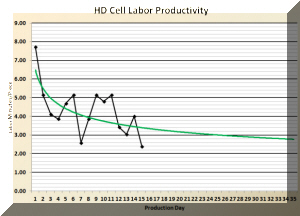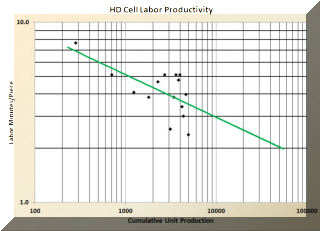Learning Curves In Cellular Manufacturing
Cellular Manufacturing, Learning Curves & Continuous Improvement

Learning & Experience Curve Synopsis
- For each doubling of total volume or repitition, cost, labor and other inputs decline by a fixed percentage.
- Many factors, including management attention, determine the specific "learning rate".
- The concept applies across a wide range of activities and organizations from individuals to entire industries.
- The reductions are consistent over long time periods of years or decades.
- At the level of workcells and workstations future cost declines are predictable.
- Athe level of Companies and industries there are important implications for Marketing and Manufacturing Strategy.
Workcell Performance
Figures 1 & 2 show the actual performance of a workcell that produced mechanical control cables. This is fairly typical of well-designed and properly implemented workcells. After about three weeks the cell had doubled productivity. At the workcell level (e.g. small work groups with limited product mix), improved productivity is from several sources.
Maintain the Learning
The slope of the learning curve is not fixed. It can change for the better through management action and training. Or, it can change for the worse, mostly through neglect. It is easy and exciting to participate in the learning experience when first starting because the improvements are dramatic and quick. As production continues for years or decades, improvements are slower in coming and incremental in nature.
In the long run, the effective maintenance of learning, continuous Improvement, may be more important. It can give a company a competitive advantage that is not easily duplicated by competitors. Toyota is the prime example.
Example--Learning in Workcell Teams
Sources of Improvement
 From a Socio-Technical perspective, these sources are either
technical improvements from equipment and processes or social improvements involving the skills and interactions of people. Both are important and mutually reinforce.
From a Socio-Technical perspective, these sources are either
technical improvements from equipment and processes or social improvements involving the skills and interactions of people. Both are important and mutually reinforce.
Technical Improvement
Technical problems with equipment, maintenance and tooling have a way of standing out in a cellular environment. Partly, this is because they tend to shut down or slow down the entire cell.
In the HD cell illustrated below, the high labor hour days usually came from equipment breakdowns or tooling problems that required repair time. In each case, attention was given to ensure proper repair or modifications that would solve the problem permanently. As these changes accumulated, productivity improved. Moreover, the cell became more predictable with less day-to-day variation in output.
The internal lot size or transfer batch was reduced. And, the work team rearranged equipment to bring it closer together, this reduced space, reduced walking effort and improved communication.
Social Side Improvements
Social side improvements come from motivation, task skills, team skills, and problem-solving skills. Several of the best methods for balancing work within the cell depend upon mutual cooperation as well. A workcell team may have a wide degree of autonomy. Some teams operate almost entirely by themselves with only occasional coaching and supervision. Others may have a supervisor or working team leader.
Motivation—in a team setting, motivation is enhance for most people. Individuals do not want to disappoint the team. This relates to Maslow's Heirarchy of Needs.
Team Skills—these "team process" skills are not innate and, for most of us, must be learned through training and practice. This requires time and may vary among different groupings of people. One or two days of team training followed by continued coaching is usually the best way to impart these skills. A team leader or coach may promote these skills without formal training of the team but this is highly dependent on the individual.
Work Balance—a series of tasks is never balanced perfectly. Even highly engineered, automotive-style assembly lines lose 20% or more to imbalance. There are several ways to achieve better balance in workcells. But, they require motivated employees and time to develop skill. As the team matures, they get better and better at balancing.
Task Skills—part of the productivity improvement from workcells comes from improving and expanding task skills. If a particular worker is less skilled, that lower skill quickly becomes a bottleneck that limits team performance. In most cases, the team will correct the problem by teaching their less-skilled member. It is also important for each worker to expand their task skills with cross-training. this makes it easier to balance the work and get maximum performance from the team.
Problem Solving—training for workcell teams often involves the traditional problem-solving or process improvement skills from Work Simplification, TQM and Six Sigma. This can accelerate improvement and teamwork as it helps the team achieve success.
Quality—order of magnitude improvements in quality are not unusual. This is especially the case for cells that involve a lot of manual work and where quality depends on focus, attention and motivation. Teamwork, engagement, proximity and rapid feedback seem to be the important factors. See our page "The Psychology of SPC" for more.
■ ■ ■ ■ ■ ■ ■





